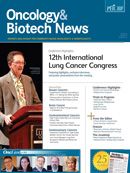Publication
Article
Physicians Uniting to Battle Flawed Medicare Reimbursement Formula
Author(s):
As millions of Americans grapple with changes in Medicare and other health insurance coverage, thousands of oncologists could find their medical practices threatened by insolvency.

As millions of Americans grapple with changes in Medicare and other health insurance coverage, thousands of oncologists could find their medical practices threatened by insolvency. In addition, the federal government’s deficit could grow considerably if Congress does not attempt to fix the flawed Medicare physician payment system.
Oncology professionals from around the country and the American Medical Association (AMA) have been voicing their concerns to Congress for a number of years, stating that the current reimbursement system is forcing clinics across the country to shut their doors, preventing patients from receiving optimal care.
“These proposed cuts to cancer care are creating the perfect storm,” said Ted Okon, executive director of the Community Oncology Alliance (COA), a group representing hundreds of community oncologists around the country.
Okon said that the effects of an imperfect reimbursement system are already being felt in a system that is already strained for resources.
Sustainable Growth Rate
In 1997, Congress established a sustainable growth rate (SGR) formula for reimbursing physicians who treat Medicare patients. The formula was based on healthcare costs and the general economy at the time. Today, if a physician’s expenditures for treating patients exceed the SGR, then reimbursement is cut. Since medical costs have risen at a rate greater than inflation, cuts to the SGR have been proposed for some time.
While cuts have been averted for the last few years, a 29.5% cut to the SGR is set to take effect on January 1, 2012, unless Congress intervenes before then. The proposed 29.5% cut is “simply unacceptable,” said David Adler, director of government relations for the American Society for Therapeutic Radiology and Oncology (ASTRO), a 10,000-member organization whose membership includes 5000 domestic radiation oncology physicians. “Congress needs to act— and act fast—to once and for all stop these cuts and fix the sustainable growth rate formula that leads to these cuts.”
Congress has intervened 12 times since 2002 to prevent cuts to reimbursement provided by the SGR formula. In 2010 alone, 5 separate federal bills were passed to stop a 22% cut, said Cecil B. Wilson, MD, immediate past president of the AMA and an internist based in Winter Park, Florida, who testified on the funding formula before the House Energy and Commerce Committee’s Subcommittee on Health.
“The formula is flawed and it has not worked right…almost since its inception,” Wilson said. “Physicians are now being paid by Medicare essentially at the same rate they have been paid since 2002. It is becoming increasingly difficult to see Medicare patients because of this.”
In 2003, the Medicare Modernization Act (MMA) was passed, effectively changing the reimbursement model for cancer drugs. Under the MMA, physicians were reimbursed for the average sales price of the drug rather than the average wholesale price. When the wholesale price reimbursement model was in place, many physicians were overcompensated for drugs, but in turn, these funds were used to offset nonpayment and underpayment of other cancer treatment options.
Congress was supposed to revise the MMA to account for unreimbursed services, such as treatment planning, but that has yet to happen. According to the COA, many drugs are reimbursed at a rate less than cost.
Limiting Services to Medicare Patients
The Medicare Payment Advisory Commission (MedPAC), a congressional agency that provides Congress with independent, nonpartisan policy and technical advice on Medicare issues, reported that 1 in 4 new Medicare patients has difficulty finding physicians willing to treat them. In addition, a recent AMA survey found that about 57% of doctors who responded reported being forced to “limit” services to Medicare patients due to a lack of Medicare reimbursement funding.
Adding urgency to the issue is the fact that Medicare serves more than 46 million beneficiaries, a number that will continue to grow as more baby boomers age. The year-toyear instability of the funding formula situation leaves physicians unable to “reliably plan ahead or fully cover their rising practice costs,” said Mark B. McClellan, MD, PhD, director of the Brookings Institution’s Engelberg Center for Health Care Reform, in his testimony before Congress.1,2
“The result is frustrating, putting pressure on physicians to do more for patients with less, and growing difficulty for physicians in bearing the cost of all the things Medicare pays for poorly, if at all: coordinating care across the different providers who see beneficiaries, educating patients about how they can stay well or manage their health problems, delivering care in less costly settings, and even spending extra time with them when they need it,” McClellan added.
AMA’s Wilson said many doctors who treat Medicare patients are already facing brutal decisions: to cut into their own practices’ finances and capabilities or to simply stop seeing Medicare patients. According to a recent AMA Physician Practice Information Survey, 78% of US office-based physicians are in practices of fewer than 9 physicians, with most in solo practice or practices involving 2 to 4 physicians. This leaves little room for the cuts they are increasingly being forced to make.
“
The result is frustrating, putting pressure on physicians to do more for patients with less, and growing difficulty for physicians in bearing the cost of all the things Medicare pays for poorly, if at all. ”
—Mark B. McClellan, MD, PhD
Yet cuts are already happening. In the COA’s Practice Impact Report, which was released earlier this year, the organization reported that at least 199 community oncology practices have shut their doors and another 315 have been absorbed by larger hospitals.
COA president David Eagle, MD, said that those effects are trickling down to the patients served by these clinics. Eagle said that many clinics are reporting shortages in generic cancer drugs. These drugs are typically dispensed at an oncologist’s office or in a hospital rather than a traditional or retail pharmacy. In 2003, the MMA limited how much the price of a particular generic drug could be raised. Even though generic drugs are substantially cheaper than their brand-name counterparts, when a shortage occurs drug prices rise to encourage multiple manufacturers to meet demand. However, because of the limits on pricing, there is little incentive for drug manufacturers to produce life-saving drugs to help resolve these shortages.
“This leads to fragmented care,” Eagle said. “A patient is taking Taxol as part of their chemotherapy, but once Taxol is unavailable, the patient has to be switched to some other drug. It’s an unintended consequence of how reimbursement is being done.”
Financial Impact of SGR
For years, Congress has failed to permanently fix the SGR formula, and every year that the issue isn’t addressed the problem increases in size and complexity. Wilson estimated that the 10-year cost of a long-term solution to the reimbursement issue has grown from about $48 billion in 2005 to nearly $300 billion today.
Yet with the Congressional Budget Office (CBO) estimating that the federal government was already $871 billion in the red through the first several months of fiscal year 2011—and running an overall deficit estimated at $13.5 trillion as of September 2010—spending more money now to prevent a larger and much more costly problem later is an agonizingly difficult thing to sell politically.1,3
“It’s one of those pay-me-now or pay-melater problems,” Wilson said. “With the Medicare program, the problem will be even greater. The route to improvement, to find a solution to this problem, is a challenge. It is not easy.”
According to the Centers for Medicare & Medicaid Services, Medicare spending accounts for roughly 3.5% of the US gross domestic product (GDP). If scheduled physician payment reductions continue to be overridden and provider payments continue to grow at current rates, Medicare expenditures could surpass 5% of the GDP by 2030 and hit 5.5% by 2035, according to McClellan. He said this would not only require substantial additional tax revenues but, if the past is any guide, that other key federal priorities will be squeezed down.
According to Glenn M. Hackbarth, chairman of the MedPAC, Medicare also consumes 18% of all income tax revenue in addition to Medicare’s dedicated payroll tax revenues, premiums, and cost sharing. That leaves those tax revenues unavailable for other national priorities or to reduce the national debt. As a result, the CBO estimates that debt held by the public is expected to be about 77% of GDP within the next decade, a level not seen since World War II.
Lobbying Congress
On March 10, 2010, a letter stating that the current SGR formula must be remediated was sent to congressional Republican and Democrat leaders. It was signed by more than 130 medical organizations, including the AMA, American Society of Clinical Oncology, American College of Surgeons, Medical Group Management Association, and 51 state medical associations and societies.
In addition, more than 100 members of ASTRO visited Washington, DC, in March 2011 to personally press congressmen on the need to replace the reimbursement formula with a way to pay physicians fairly. COA held a similar gathering in September to urge Congress to make major overhauls in Medicare reimbursement for oncologists.
AMA recommended a 5-year period of stable Medicare physician payments that keep pace with the growth in medical practice costs. This coincides with the transition to an array of new payment models developed by policymakers, stakeholders, and experts that would be designed to enhance care coordination, quality, appropriateness, and costs.
As for the COA, its recommendation follows the oncology patient-centered medical home model. The model, which was developed by Consultants in Medical Oncology & Hematology, PC, in Drexel Hill, Pennsylvania, manages each patient by a physician-led care team. When a patient is diagnosed with cancer, that practice team coordinates all aspects of treatment, meaning that all nononcologic medical issues would also be kept in-house.
By following this model, members of the COA believe that increased communication between patients and physicians, patient compliance monitoring, standardization of care, increased patient education, and increased accountability would create less of a burden on the healthcare system. The healthcare system would become performance-based, and improved coordination would lower the cost of care.
“We’re trying to bring a possible solution [to the SGR issue] to Congress,” said Eagle.
References
- Medicare Payment Advisory Commission. Report to the Congress: Medicare Payment Policy. MedPac’s report to Congress on the Medicare payment policy. March 15, 2011. Available at: www.medpac.gov. Accessed August 17, 2011.
- McClellan MB. The need to move beyond the sustainable growth rate in Medicare. May 5, 2011. Available at: www.brookings.edu. Accessed August 17, 2011.
- TreasuryDirect. Historical debt outstanding: annual 2000-2010. Available at: www.treasurydirect.gov. Accessed August 17, 2011.









